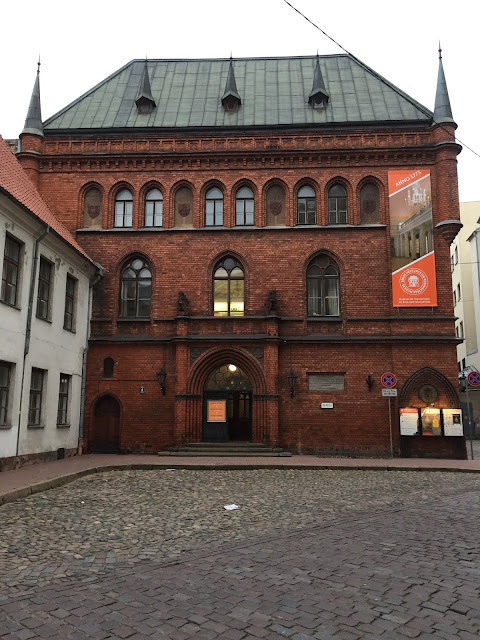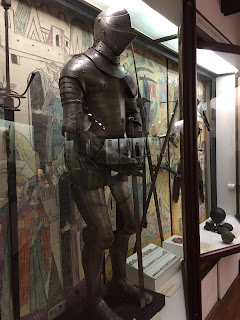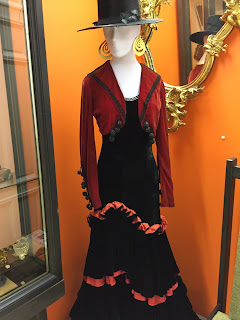200. Regional Travel #4.7 - Museum of the History of Riga and Navigation
The Museum of the History of Riga and Navigation is among the more strangely-named places I've visited in Latvia. A history museum is certainly normal, but the "...and Navigation" part of the name takes things in a different direction (actually, the museum has had many names over the centuries, and did not acquire this moniker until 1964). As it turns out, this is more or less a standard city history museum. The building housing the museum is part of the Riga Dom complex, with the north side of the building looking out on the courtyard between the cloisters and the Dom Church.
The museum has been located here in the center of Riga since 1773, and is the oldest public museum in the Baltic region (and among the oldest in all of Europe). The museum tells the 800-year history of Riga via thousands of artifacts spread through 16 rooms. A smaller portion of the exhibits covers the history of seafaring and commerce in the Baltic Sea over the last millennium. This focus differs significantly from the exhibits at the National History Museum of Latvia, and so between the two institutions, I definitely learned a great deal about the city and surrounding region.
St. Christopher is the patron saint of travelers and protector against water-related hazards, and a cult dedicated to him emerged in Livonia in the first half of the fifteenth century. His statues made me think of my brother Christopher and his young son:
Riga is where evergreen trees were first decorated to mark the Christmas holiday, when in 1510 members of the Riga Brotherhood of the Blackheads (a guild for tradesmen and ship captains) brought a tree from the forest to the town to burn in place of a yule log, and instead children decorated it with nuts, apples, garlands, and wreaths. Seen here is a stone Christmas tree decoration from the 1600s or 1700s:
The most impressive room in the museum - the Column Hall - was built between 1778 and 1786 to serve as the Riga City Library. More than 12,000 manuscripts and printed volumes were housed here between 1787 and 1891, after which the room was used by the Dom Church. Following World War II, the room was turned over to the museum:
Maces and goblets from the trade guilds, dating to the eighteenth and nineteenth centuries:
The museum collections include a variety of silver vessels and sculptures (including some twenty-first century pieces):
The portion of the museum related to navigation (specifically, seafaring in the Baltic Sea) is relatively small, and occupies perhaps two or three rooms:
A special exhibit "Time Music: Timepieces from the collection of the History of Riga and Navigation. 17th-20th centuries" presented highlights from the museum's collection of more than 500 timepieces. Some of the watches are made in Latvia, while the majority of the collection was made by clockmakers in Russia, Europe, and the United States. All the timepieces were restored and are (noisily) running, hence the exhibit's name, "Time Music".
The museum has been located here in the center of Riga since 1773, and is the oldest public museum in the Baltic region (and among the oldest in all of Europe). The museum tells the 800-year history of Riga via thousands of artifacts spread through 16 rooms. A smaller portion of the exhibits covers the history of seafaring and commerce in the Baltic Sea over the last millennium. This focus differs significantly from the exhibits at the National History Museum of Latvia, and so between the two institutions, I definitely learned a great deal about the city and surrounding region.
St. Christopher is the patron saint of travelers and protector against water-related hazards, and a cult dedicated to him emerged in Livonia in the first half of the fifteenth century. His statues made me think of my brother Christopher and his young son:
Riga is where evergreen trees were first decorated to mark the Christmas holiday, when in 1510 members of the Riga Brotherhood of the Blackheads (a guild for tradesmen and ship captains) brought a tree from the forest to the town to burn in place of a yule log, and instead children decorated it with nuts, apples, garlands, and wreaths. Seen here is a stone Christmas tree decoration from the 1600s or 1700s:
The most impressive room in the museum - the Column Hall - was built between 1778 and 1786 to serve as the Riga City Library. More than 12,000 manuscripts and printed volumes were housed here between 1787 and 1891, after which the room was used by the Dom Church. Following World War II, the room was turned over to the museum:
Maces and goblets from the trade guilds, dating to the eighteenth and nineteenth centuries:
The museum collections include a variety of silver vessels and sculptures (including some twenty-first century pieces):
Several rooms presented the material culture of the late nineteenth and
early twentieth centuries (in a somewhat disorganized fashion, and with
relatively little interpretation):
The portion of the museum related to navigation (specifically, seafaring in the Baltic Sea) is relatively small, and occupies perhaps two or three rooms:
A special exhibit "Time Music: Timepieces from the collection of the History of Riga and Navigation. 17th-20th centuries" presented highlights from the museum's collection of more than 500 timepieces. Some of the watches are made in Latvia, while the majority of the collection was made by clockmakers in Russia, Europe, and the United States. All the timepieces were restored and are (noisily) running, hence the exhibit's name, "Time Music".


































































Comments
Post a Comment